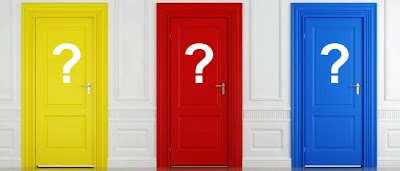I'm on a wander today, subject wise. Coincidences are often said to be pure chance or that they are all down to probability. I don't believe this myself. Okay, I'll change my mind: some are but synchronicity isn't. But that's the trouble when you change your mind the odds or probability of being correct alter as well.
Lets look at the three doors above. You have to guess which one hides a big prize. You choose a door, say red, where you think the prize is behind. I then open one of empty doors, say yellow.
If I now ask you if you want to stick with your red chosen door or switch to the blue door what should you do?
The question is: Should you switch doors?
Here's a photo of three horses I saw yesterday also ruminating the problem:
The Answer: Yes, you should switch doors.
Most people will say it makes no difference to the odds but ...
If you swap, you win when your initial guess was wrong, probability 2/3.
If you stick, you only win when your initial guess was correct, probability 1/3.
The Cambridge University + Plus Magazine writes the following about this probability puzzle.
"This problem has been around for many years. A similar problem was published in Scientific American about 40 years ago. The author, Martin Gardner, went on to say that 'in no other branch of mathematics is it so easy for experts to blunder as in probability theory'.
This observation couldn't have been closer to the truth. Although the problem was picked up in 1975 and published in the American Statistician it did not become famous until 1990 when Marilyn vos Savant, reputedly the most intelligent person in the world, wrote about it in the American Parade Magazine.
In her column she described an American TV game show called Let's Make a Deal in which the compère, Monty Hall, presents the contestant with three doors. Behind one of them is a car, behind the others a goat. Once the contestant has chosen a door Monty Hall opens one of the other two doors to reveal a goat and then offers the switch.
Marilyn was inundated with thousands of letters, many from professional mathematicians, disputing her solution. Feelings ran so high that eventually Monty Hall himself became involved. It turns out that in the real show he wasn't obliged to offer the switch at all. If the contestant chose a door with a goat he might open it straight away - too bad! Even if he did offer the switch, he would use bribes to trick the contestant into taking the goat. "They'd think the odds on their door had now gone up to 1 in 2, so they hated to give up the door no matter how much money I offered." he said.
Still, if these ambiguities seem like an excuse then think again. People still get the problem wrong, even when it is stated carefully. The problem has spread from one discussion forum to another, it has appeared in numerous places on the Internet and has recently been discussed in the British magazine New Scientist.
Does all of this actually help us understand coincidences or synchronicity any better. Well, not really but it does no harm to give the mind a work out. Being switched on makes us more aware of coincidences and synchronicity in our lives - probably!
So what are the odds of these coincidences happening?
Married Couple In The Same Photo As Children
Synchronicity Of A Beatles Song Sealed Their Romance
The Red Balloon Coincidence
P.S. There is also another similar puzzle: A shopkeeper says she has two new baby beagles to show you, but she doesn't know whether they're male, female, or a pair. You tell her that you want only a male, and she telephones the fellow who's giving them a bath. "Is at least one a male?" she asks him. "Yes!" she informs you with a smile. What is the probability that the other one is a male?



Good one! It's a quantum wave that doesn't crash into physical reality as a particle until one door is opened. That's how I have seen it explained.
ReplyDeleteThat's a bit too technical for me, Trish! but I get what you are saying.
DeleteOkay, I just came by to visit, and read something I might better understand. Just for giggles, I would have kept the red door... oops!
ReplyDeleteActually I think people would be influenced by the colours of the doors - so ideally they should all be the same. I'd have chosen red.
Delete